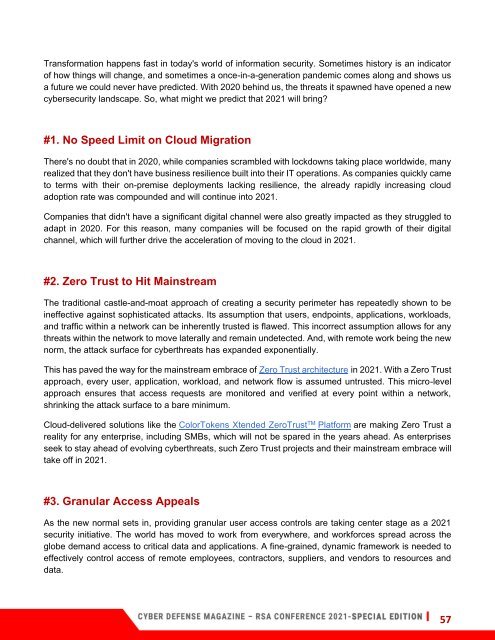Cyber Defense Magazine Special Annual Edition for RSA Conference 2021
Cyber Defense Magazine Special Annual Edition for RSA Conference 2021 - the INFOSEC community's largest, most popular cybersecurity event in the world. Hosted every year in beautiful and sunny San Francisco, California, USA. This year, post COVID-19, virtually with #RESILIENCE! In addition, we're in our 9th year of the prestigious Global InfoSec Awards. This is a must read source for all things infosec.
Cyber Defense Magazine Special Annual Edition for RSA Conference 2021 - the INFOSEC community's largest, most popular cybersecurity event in the world. Hosted every year in beautiful and sunny San Francisco, California, USA. This year, post COVID-19, virtually with #RESILIENCE! In addition, we're in our 9th year of the prestigious Global InfoSec Awards. This is a must read source for all things infosec.
You also want an ePaper? Increase the reach of your titles
YUMPU automatically turns print PDFs into web optimized ePapers that Google loves.
Trans<strong>for</strong>mation happens fast in today's world of in<strong>for</strong>mation security. Sometimes history is an indicator<br />
of how things will change, and sometimes a once-in-a-generation pandemic comes along and shows us<br />
a future we could never have predicted. With 2020 behind us, the threats it spawned have opened a new<br />
cybersecurity landscape. So, what might we predict that <strong>2021</strong> will bring?<br />
#1. No Speed Limit on Cloud Migration<br />
There's no doubt that in 2020, while companies scrambled with lockdowns taking place worldwide, many<br />
realized that they don't have business resilience built into their IT operations. As companies quickly came<br />
to terms with their on-premise deployments lacking resilience, the already rapidly increasing cloud<br />
adoption rate was compounded and will continue into <strong>2021</strong>.<br />
Companies that didn't have a significant digital channel were also greatly impacted as they struggled to<br />
adapt in 2020. For this reason, many companies will be focused on the rapid growth of their digital<br />
channel, which will further drive the acceleration of moving to the cloud in <strong>2021</strong>.<br />
#2. Zero Trust to Hit Mainstream<br />
The traditional castle-and-moat approach of creating a security perimeter has repeatedly shown to be<br />
ineffective against sophisticated attacks. Its assumption that users, endpoints, applications, workloads,<br />
and traffic within a network can be inherently trusted is flawed. This incorrect assumption allows <strong>for</strong> any<br />
threats within the network to move laterally and remain undetected. And, with remote work being the new<br />
norm, the attack surface <strong>for</strong> cyberthreats has expanded exponentially.<br />
This has paved the way <strong>for</strong> the mainstream embrace of Zero Trust architecture in <strong>2021</strong>. With a Zero Trust<br />
approach, every user, application, workload, and network flow is assumed untrusted. This micro-level<br />
approach ensures that access requests are monitored and verified at every point within a network,<br />
shrinking the attack surface to a bare minimum.<br />
Cloud-delivered solutions like the ColorTokens Xtended ZeroTrust TM Plat<strong>for</strong>m are making Zero Trust a<br />
reality <strong>for</strong> any enterprise, including SMBs, which will not be spared in the years ahead. As enterprises<br />
seek to stay ahead of evolving cyberthreats, such Zero Trust projects and their mainstream embrace will<br />
take off in <strong>2021</strong>.<br />
#3. Granular Access Appeals<br />
As the new normal sets in, providing granular user access controls are taking center stage as a <strong>2021</strong><br />
security initiative. The world has moved to work from everywhere, and work<strong>for</strong>ces spread across the<br />
globe demand access to critical data and applications. A fine-grained, dynamic framework is needed to<br />
effectively control access of remote employees, contractors, suppliers, and vendors to resources and<br />
data.<br />
57


















